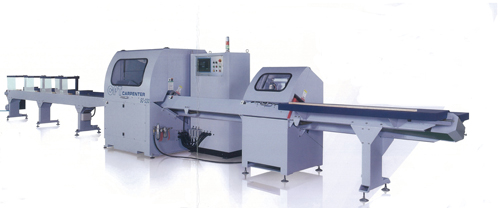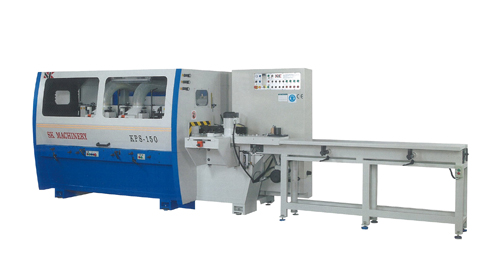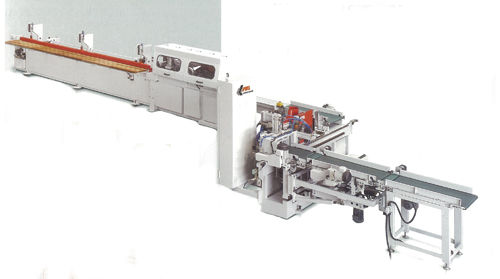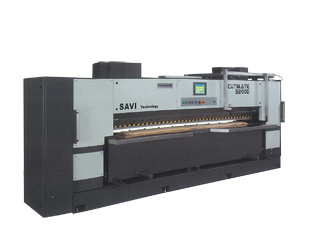Woodworking Machinery Makers Cope by Adding Value
2012/01/02 | By Ken LiuAlso repeated in other sectors, China's woodworking machinery industry has unseated Taiwan as the world's No.3 supplier by underselling. Nevertheless, Taiwan exported in 2010 equipment totaling US$556 million, up 57.47% from a year earlier, which is attributable mostly to the comparatively low 2009 base due to the financial meltdown of 2008 and increased exports of eco-friendly, high-efficiency machines.
Anderson Group
The Anderson Group, for instance, is proud of developing eco-friendly woodworking machines. A recently developed line of computerized wood-grain printers, shipped mostly to the United States, China, Europe and domestically, are popular for creating lifelike wood-grains on non-wood surfaces, using ultraviolet drying and inkjet technologies to achieve excellent efficiency.
According to the general manager of precision-machinery operation, W.J. Yang, the motifs can be sanded off for reapplication as desired, so fewer trees are felled to meet ever-changing consumer demands.
The printing system is versatile, able to print other natural patterns as marble and even stained glass often seen in church glazing, with the graphics program being virtually limitless in capacity, Yang claims.
The major technical hurdle to clear has been to formulate a lacquer that can adhere to hard, smooth surfaces for extended duration, which calls for specific mixtures for outdoor and indoor applications. Outdoor lacquers are specially formulated to withstand UV radiation and acid rain, while all the paints are eco-friendly, stresses the general manager.

Introducing the printing system around three years ago was a strategy to evade the overcrowded CNC-router segment for markets with still reasonable profit margins. Founded in 1972, the company is recognized as Taiwan's first to launch a CNC-router in 1985. “Now every woodworking equipment maker offers a CNC router. We just tapped CNC technology to build the printing system, an item with higher added-value,” Yang explains.

With R&D offices in Germany, the United States, Singapore, Taiwan and China,
Anderson has been transforming with strong R&D background, cultivated mostly by acquiring technology from long-term German partner HOMAG Group, recognized as the world's No.1 woodworking-equipment supplier.
Boway Technology
Boway Technology Co., Ltd. sets an example in multi-functionality with its BWM-FN481 AV five-axis CNC machining center for woodworking.
Besides being able to process along X, Y, Z, A and C axes, this machine can handle wood furniture, car bumpers, wood molds, footwear molds, vessel parts, or even artworks, as well as label a finished workpiece with a barcode containing data as processing date, serial number and application.
The company added the barcode labeling in 2010, two years after the five-axis machine was launched. “This is Taiwan's first five-axis CNC machining center with barcode labeling, which enables handling of products by automated warehousing system to enhance logistics efficient and save manpower,” stresses Bill Hung, the chairman.

The BWM-FN481AV is outfitted with the British-made OSAI five-axis computerized controller, and a 1,220mm x 2,440mm worktable ideal for larger work pieces.
Carpenter Machinery
Carpenter Machinery Co., Ltd. specializes in sawing, planing, and molding machines, drawing buyers with computerized machines capable of cutting production cost and enhancing eco-friendliness, with the latest machines being SC-230 cutting machine, GRS-450A multiple rip sawing machine, and S-400E grinding machine.
SC-230 and GRS-450A are touted as “optimal” machines for being able to locate the best cutting condition after accounting for parameters entered into the computer by users.
SC-230's computer accepts 10 parameters as length, waste reduction, cost, and cutting section. Users enter material parameters as unwanted knots and defects which are marked by onboard sensors, with the machine then cutting away unwanted parts precisely.
This machine has a touch screen and does not need programming pros to operate, as well as able to maximize profits for users, says the president, C.S. Chang.
With a 7.5KW, 10HP motor, 20-inch diameter blade running at 4,800 RPM, this machine cuts solid-wood and medium-density boards.
The SC-230 automatically sorts finished pieces according to preprogrammed sizes, another labor-saving design, with conveying lanes handling several boards simultaneously of different lengths and marked with various defect spots.

The S-400E grinds scrap wood for recycling to help reduce usage of virgin wood.
Shun Kuang Machinery Factory
Shun Kuang Machinery Factory's KPS-150 four-sided planer helps woodworkers with the dilemma of having to either toss remnants or keep them for questionable value.
Able to cut pieces to only 150mm lengths and with processing speed of 60 meters per minute, this machine is developed around the idea to maximize value of wood to help conserve global forests, stresses the sales manager, Cliff Chang.
The KPS-150 is mostly used to plane pieces for finger-jointing on machines from manufacturers like Cheng Kuang Wood Machinery Works Co., Ltd.
Cheng Kuang is promoting its FL-24 automatic finger jointing line, which specifically works on pieces no shorter than 90mm. Wasting minimally, this machine cuts away only 10mm from a 90mm-long panel, as well as being very accurate with a length tolerance of 0-2mm on joint cuts.
The FL-24, with 90-1,000mm in length capacity and 30-160mm in width capacity,
is efficient, using only one shaper to score, end trim, shape and finger finish both ends of a piece. A 180-degree swivel table turns unfinished ends for shaping in turn two to three times per minute.
This machine is fast, precise and completely automatic, unlike traditional machines depending on manual operation, says Ethan Tu, Cheng Kung's sales manager.
Innovator Machinery Co., Ltd.
Innovator Machinery Co., Ltd.'s CutMate3200 veneer guillotine and LVS-1250 VeneerPlus longitudinal veneer splicer are also eco-friendly. CutMate3200 has a single-knife that cuts wood veneers as thin as 0.35mm to 2.5mm while VeneerPlus joins veneers.
The CutMate3200 is innovative and co-developed with Danish manufacturer SAVI, able to reduce wood waste thanks to a positioning laser and computer memory optimized for cutting, while sturdy mechanical design significantly enhances cutting stability.
VeneerPlus makes perfect veneer joining without leaving seams along edges. Unlikely traditional veneer splicing machines, which employ stitch or paper-taping method, VeneerPlus uses unique heating and pressing to eliminate seams, as well as a unique integrated gluing system between conveyors and feed rollers to eliminate pre-gluing usually seen on traditional machines.
This is an integrated machine with feed rollers, gluing unit, heating/processing unit and splicer.
ICT Helps
The Taiwan Woodworking Machinery Association (TWMA), representing around 300 woodworking-equipment manufacturers, plans to invite the Center to assist members to use ICT to further sharpen their competitiveness to take on mainland China's rivals.
The Center is assisting the island's machine-tool manufacturers to set up remote control systems with wireless imaging technology. “We estimate the system can reduce cost of labor and waste by half every year for manufacturers,” he says, while showing a slide illustrating that a typical machine-tool manufacturer employing 20 workers can halve the staff to 10 and payroll to NT$4.2 million (US$140,000), as well as save a projected NT$7.2 million (US$240,000) in wasted material in half a year.




